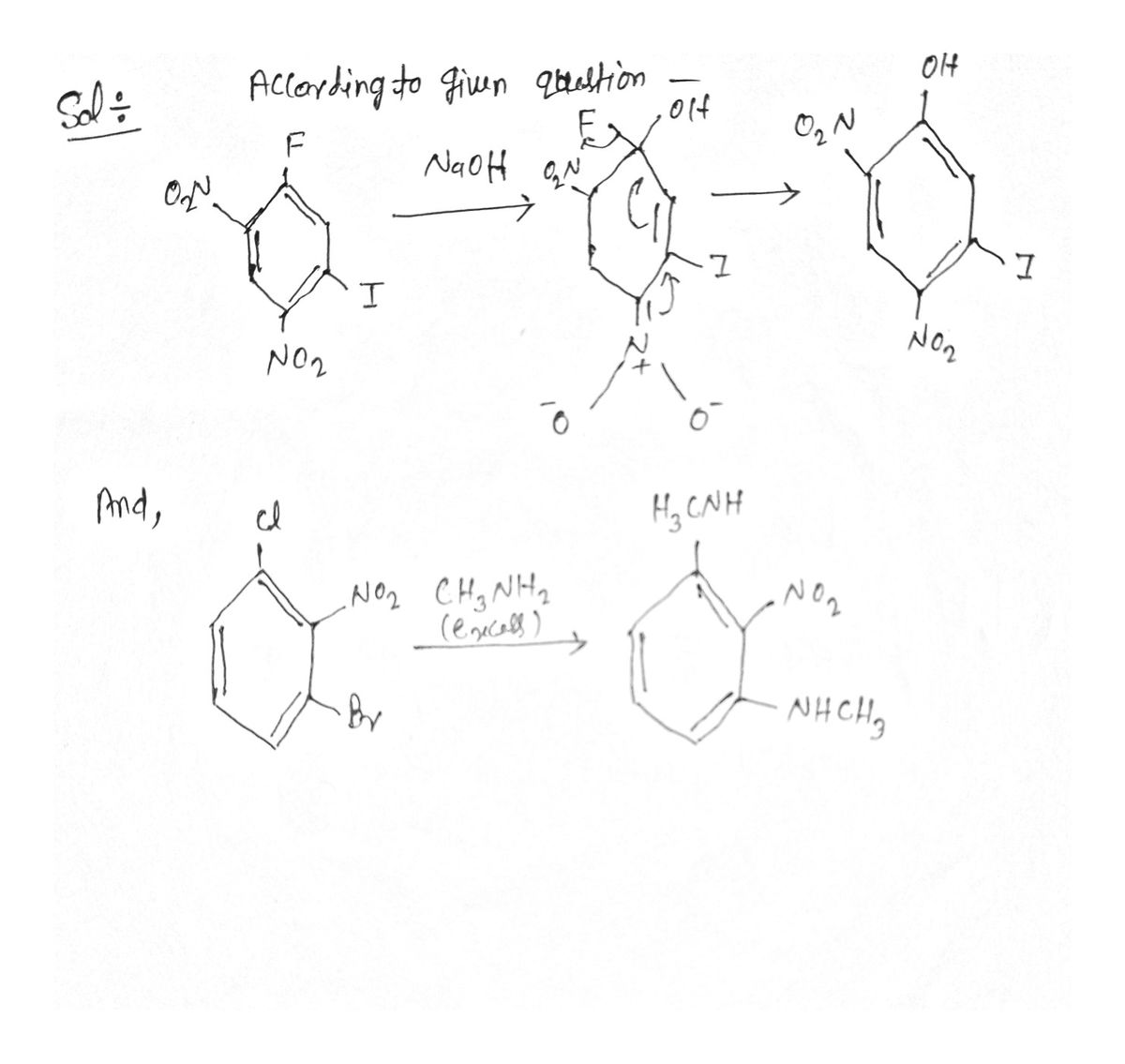Chemistry
10th Edition
ISBN:9781305957404
Author:Steven S. Zumdahl, Susan A. Zumdahl, Donald J. DeCoste
Publisher:Steven S. Zumdahl, Susan A. Zumdahl, Donald J. DeCoste
Chapter1: Chemical Foundations
Section: Chapter Questions
Problem 1RQ: Define and explain the differences between the following terms. a. law and theory b. theory and...
Related questions
Question
Please make sure it's detailed mechanism with arrows in every step, thank you

Transcribed Image Text:### Chemical Reaction Mechanisms
3. **Draw the detailed mechanism and predict the major product of each of the following reactions.**
**Reaction A:**
A benzene ring with:
- Fluorine (F) at the 1-position
- Two nitro groups (NO₂) at the 2- and 4-positions
- Iodine (I) at the 3-position
This compound reacts with sodium hydroxide (NaOH).
**Mechanism Details:**
- The reaction likely involves nucleophilic aromatic substitution, considering the electron-withdrawing nature of the NO₂ groups activating the ring for substitution.
- NaOH acts as the nucleophile.
**Expected Product:**
- The iodide group is expected to be replaced by the hydroxyl group (OH).
**Reaction B:**
A benzene ring with:
- Chlorine (Cl) at the 1-position
- A nitro group (NO₂) at the 3-position
- Bromine (Br) at the 4-position
This compound reacts with excess methylamine (CH₃NH₂).
**Mechanism Details:**
- The reaction likely involves nucleophilic aromatic substitution.
- The electron-withdrawing NO₂ group activates the ring for substitution by CH₃NH₂.
- Excess CH₃NH₂ suggests an emphasis on its role as the nucleophile to replace either Br or Cl.
**Expected Product:**
- The halogen, likely Br due to weaker bond strength compared to Cl, is expected to be replaced by an NH₃CH₃ group.
These reactions demonstrate classic nucleophilic aromatic substitution mechanisms facilitated by electron-withdrawing groups on an aromatic ring.
Expert Solution
Step 1

Step by step
Solved in 2 steps with 1 images

Knowledge Booster
Learn more about
Need a deep-dive on the concept behind this application? Look no further. Learn more about this topic, chemistry and related others by exploring similar questions and additional content below.Recommended textbooks for you

Chemistry
Chemistry
ISBN:
9781305957404
Author:
Steven S. Zumdahl, Susan A. Zumdahl, Donald J. DeCoste
Publisher:
Cengage Learning

Chemistry
Chemistry
ISBN:
9781259911156
Author:
Raymond Chang Dr., Jason Overby Professor
Publisher:
McGraw-Hill Education

Principles of Instrumental Analysis
Chemistry
ISBN:
9781305577213
Author:
Douglas A. Skoog, F. James Holler, Stanley R. Crouch
Publisher:
Cengage Learning

Chemistry
Chemistry
ISBN:
9781305957404
Author:
Steven S. Zumdahl, Susan A. Zumdahl, Donald J. DeCoste
Publisher:
Cengage Learning

Chemistry
Chemistry
ISBN:
9781259911156
Author:
Raymond Chang Dr., Jason Overby Professor
Publisher:
McGraw-Hill Education

Principles of Instrumental Analysis
Chemistry
ISBN:
9781305577213
Author:
Douglas A. Skoog, F. James Holler, Stanley R. Crouch
Publisher:
Cengage Learning

Organic Chemistry
Chemistry
ISBN:
9780078021558
Author:
Janice Gorzynski Smith Dr.
Publisher:
McGraw-Hill Education

Chemistry: Principles and Reactions
Chemistry
ISBN:
9781305079373
Author:
William L. Masterton, Cecile N. Hurley
Publisher:
Cengage Learning

Elementary Principles of Chemical Processes, Bind…
Chemistry
ISBN:
9781118431221
Author:
Richard M. Felder, Ronald W. Rousseau, Lisa G. Bullard
Publisher:
WILEY